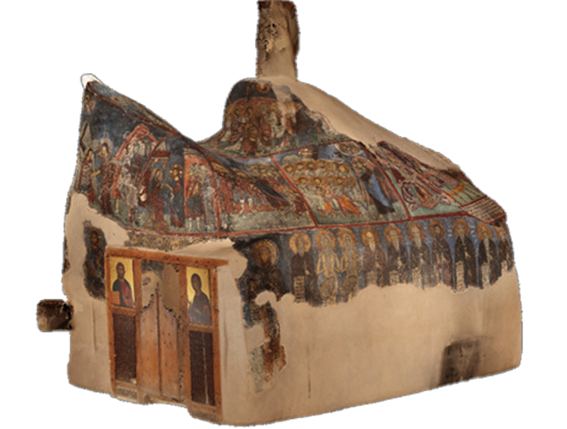1. Introduction
The Hermitage (enkleistra) of Saint Neophytos is one of the most celebrated Byzantine twelfth-century monuments worldwide, given the high quality and the unique iconographic program of its frescoes, encountered nowhere else in the Byzantine world, as well as the fact that the whole complex was cut in rock.
The monument is connected with an important intangible heritage. The community that was built and organised around Neophytos has been the centre of intellectual production with strong connections to the Byzantine elites of the island and the capital of the Byzantine empire (Constantinople), during the tumultuous period spanning the last decades of the Byzantine era -which ended with the conquest of the island by Richard the Lionheart in 1191- through the first decades of the Frankish period of Cyprus.
The intellectual production at the Enkleistra is evidenced by the writings of Neophytos and the composition of the pictorial narratives of the frescoes. The latter has been studied extensively in the past, whereas the writings of Neophytos, as well as the artefacts produced by or connected to the members of the circle of Neophytos both monks and laymen, have made the object of far less study.
Life of Saint Neophythos
Saint Neophytos the Recluse (1134-ca.1214) is one of the most important Cypriot Saints and historic figures. He was a prolific writer who composed his biography, an account of the first years of the Latin conquest of the island, as well as several theological treatises. At the age of 17, he became a monk at Koutsoventis Monastery. In search of a solitary life, he quit this Monastery two years later. After many adventures, he decided to become an ascetic in the mountainous area above the city of Paphos. In 1159 he started building his cell, by enlarging and modifying an already existing cave, which was expanded into a complex comprising three caves: the Cell, the Bema and the Naos dedicated to the Holy Cross.
Neophytos soon became a well-known spiritual figure and in 1170 he was forced by Basil Kinnamos, the bishop of Paphos at the time, to accept a disciple. During this same period, the Enkleistra began to be extended and adorned with paintings, while the whole cliff was excavated for the creation of additional cells. This extension phase included possibly as well the Refectory, which was also adorned. According to Neophytos’ testimony, however, the Naos was excavated in 1183. The increasing number of pilgrims visiting him obliged Neophytos to dig another cave above the first one (the so-called New Zion), in search of solitude and inner peace. This latter cave was completed and painted by the end of 1197. According to written testimonies, the Enkleistra was painted in 1183 by Theodoros Apseudis, likely a Constantinopolitan painter who came to Cyprus at the instigation of the bishop of Paphos Basil Kinnamos. To the same painter are also attributed the Bema and the Naos of the church of the Virgin at Lagoudera (UNESCO World Heritage monument in Cyprus, dated ca. 1192), as well as at least seven icons currently owned by different ecclesiastical institutions in Cyprus.
3. Estimation of Complexity & Quality
The following radial charts are base on the based on the EU 3D Study/VIGIE 2020/654

Complexity
Quality
6. Research Output
Videos
7. Bibliography
- Coureas, Nicholas, The foundation rules of medieval Cypriot monasteries: Makhairas and St. Neophytos, Cyprus Research Centre, Λευκωσία 2003, ISBN 978-9963-0-8080-9
- Englezakis, Benedict, Studies on the History of the Church of Cyprus, 4th-20th Centuries, Variorum, Aldershot, Hampshire Αγγλίας 1995, ISBN 978-0-86078-486-9
- Epstein, Ann Wharton (1981), «Formulas for Salvation: A Comparison of Two Byzantine Monasteries and their Founders», Church History, τόμος 50(4), σσ. 385-400
- Galatariotou, Catia: The Making of a Saint, The Life, Times and Sanctification of Neophytos the Recluse, Cambridge University Press, Cambridge 2002, ISBN 978-0-521-52188-8
- Mango, C.A. & Hawkins, E.J.W. (1966), «The Hermitage of St. Neophytos and Its Wall Paintings», Dumbarton Oaks Papers 20, σσ. 119-206 *[p. 127 &129]
- Papageōrgiou, Athanasios, The Monastery of Agios Neophytos: History and Art (a short guide), έκδοση της μονής, Λευκωσία 1998, ISBN 978-9963-614-03-5
- Tsiknopoullos, Ioannis P., The Encleistra and Saint Neophytos, Zavallis Press, Λευκωσία 1965












